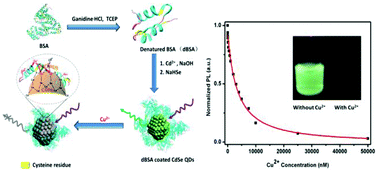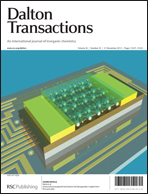Bioinspired, direct synthesis of aqueous CdSe quantum dots for high-sensitive copper(ii) ion detection†
Abstract
Luminescent CdSe semiconductor quantum dots (QDs), which are coated with a denatured bovine serum albumin (dBSA) shell, have been directly synthesized via a bioinspired approach. The dBSA coated CdSe QDs are ultrasmall (d < 2.0 nm) with a narrow size distribution and exhibit a strong green fluorescent emission at about 525 nm. They can be stored for months at room temperature and possess excellent stability against ultraviolet irradiation, high salt concentration, and a wide physiological range of pH. Systematic experimental investigations have shown the contribution of dBSA with free cysteine residues for both their effective ion chelating and surface passivating interactions during the formation and stabilization of CdSe QDs. The luminescent QDs are used for copper(II) ion detection due to their highly sensitive and selective fluorescence quenching response to Cu2+. The concentration dependence of the quenching effect can be best described by the typical Stern–Volmer equation in a linearly proportional concentration of Cu2+ ranging from 10 nM to 7.5 μM with a detection limit of 5 nM. As confirmed by various characterization results, a possible quenching mechanism is given: Cu2+ ions are first reduced to Cu+ by the dBSA shell and then chemical displacement between Cu+ and Cd2+ is performed at the surface of the ultrasmall metallic core to impact the fluorescence performance.


 Please wait while we load your content...
Please wait while we load your content...